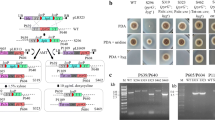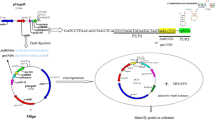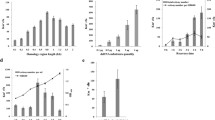Abstract
The extremophilic bacterium Deinococcus radiodurans R1 has been considered as an attractive microorganism due to its remarkable tolerance to various external stresses. Considering the nature of D. radiodurans R1, it has potential as a platform microorganism for industrial applications, including biorefinery and bioremediation process. However, D. radiodurans R1 is well known for its hard genetic manipulation. Thus, much effort has been made to develop efficient genetic engineering tools for making D. radiodurans R1 suitable for industrial platform microorganism. Although a plasmid-based single gene knockout method has been reported, development of multiple gene knockout system has not yet been reported. Here we report, for the first time, Cre-lox based rapid and efficient multiple knockout method for metabolic engineering of D. radiodurans R1. Also, deletion of dr0053 gene was successfully achieved within seven days to make biofilm overproducing strain.
Similar content being viewed by others
References
R. R. Kumar and S. Prassad, Indian J. Microbiol., 51, 403 (2011).
S. Singh, S. H. Kang, A. Mulchandani and W. Chen, Curr. Opin. Biotechnol., 19, 437 (2008).
J. Esther, L. B. Sukla, N. Pradhan and S. Panda, Korean J. Chem. Eng., 31, 1 (2015).
C. Roh, C. Kang and J. R. Lloyd, Korean J. Chem. Eng., 32, 1720 (2015).
G. Stephanopoulos, ACS Synth. Biol., 1, 514 (2012).
V. G. Vikramaditya, M. D. Mey, C. G. Lim, P. K. Ajikumar and G. Stephanopoulos, Metab. Eng., 14, 233 (2012).
K. S. Makarova, L. Aravind, Y. I. Wolf, R. L. Tatusov, K. W. Minton, E. V. Koonin and M. J. Daly, Microbiol. Mol. Biol. Rev., 65, 44 (2001).
R. Shashidhar, S. A. Kumar, H. S. Misra and J. R. Bandekar, Can. J. Microbiol., 56, 195 (2010).
J. K. Grimsley, C. I. Masters, E. P. Clark and K. W. Minton, Int. J. Radiat. Biol., 60, 613 (1991).
H. Brim, S. C. McFarlan, J. K. Fredrickson, K. W. Minton, M. Zhai, L. P. Wackett and M. J. Daly, Nat. Biotechnol., 18, 85 (2000).
H. Brim, J. P. Osborne, H. M. Kostandarithes, J. K. Fredrickson, L. P. Wacklett and M. J. Daly, Microbiology, 152, 2469 (2006).
K. Abremski, R. Hoess and N. Sternberg, Cell, 32, 1301 (1983).
R. Hoess and K. Abremski, J. Mol. Biol., 181, 351 (1985).
H. Ohba, K. Satoh, T. Yanagisawa and I. Narumi, Gene, 363, 133 (2005).
R. Meima and M. E. Lidstrom, Appl. Environ. Microbiol., 66, 3856 (2000).
H. H. Nguyen, C. B. de la Tour, M. Toueille, F. Vannier, S. Sommer and P. Servant, Mol. Microbiol., 73, 240 (2009).
K. Satoh, Z. Tu, H. Ohba and I. Narumi, Plasmid, 62, 1 (2009).
D. Appukuttan, H. S. Seo, S. W. Jeong, S. H. Im, M. H. Joe, D. S. Song, J. J. Choi and S. Y. Lim, PLoS One, 10, e0118275 (2015).
G. A. O’Toole, L. A. Pratt, P. I. Watnick, D. K. Newman, V. B. Weaver and R. G. Kolter, Method Enzymol., 310, 91 (1999).
B. R. Boles and A. R. Horswill, PLoS Pathog., 4, e1000052 (2008).
B. E. Moseley and J. K. Setlow, Proc. Natl. Acad. Sci. U.S.A., 61, 176 (1968).
J. M. Lambert, R. S. Bonger and M. Kleerebezem, Appl. Environ. Microbiol., 73, 1126 (2007).
R. Dixit, Wasiullah,_D. Malaviya, K. Pandiyan, U. B. Singh, A. Sahu, R. Shukla, B. P. Singh, J. P. Rai, P. K. Sharma, H. Lade and D. Paul, Sustainability,, 7, 2189 (2015).
M. Kolari, J. Nuutinen and M. S. Salkinoja-Salonen, J. Ind. Microbiol. Biotechnol., 27, 343 (2001).
D. Slade and M. Radman, Microbiol. Mol. Biol. Rev., 75, 133 (2011).
L. Lemee, E. Peuchant, M. Clerc, M. Brunner and H. Pfander, Tetrahedron, 53, 919 (1997).
E. Gerber, R. Bernard, S. Castang, N. Chabot, F. Coze, A. Dreux-Zigha, E. Hauser, P. Hivin, P. Joseph, C. Lazarelli, G. Letellier, J. Olive and J.-P. Leonetti, J. Appl. Microbiol., 119, 1 (2015).
Author information
Authors and Affiliations
Corresponding author
Additional information
These authors contributed equally to this work.
Rights and permissions
About this article
Cite this article
Jeong, SW., Yang, J.E., Im, S. et al. Development of Cre-lox based multiple knockout system in Deinococcus radiodurans R1. Korean J. Chem. Eng. 34, 1728–1733 (2017). https://doi.org/10.1007/s11814-017-0082-5
Received:
Accepted:
Published:
Issue Date:
DOI: https://doi.org/10.1007/s11814-017-0082-5




